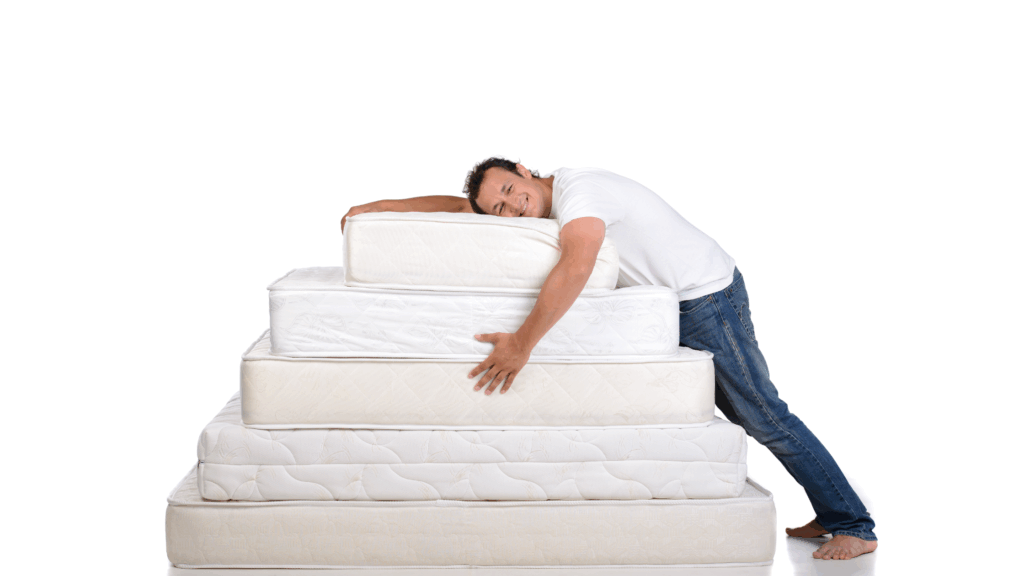Choosing the best mattress for low back pain can be surprisingly difficult. Most mattresses feel wonderful when you first lie down in a store, especially after a long day of shopping, but the real test comes after several nights of sleep on the mattress. The right mattress can reduce pain, improve posture, and support spinal health, while the wrong one can make back pain worse. Understanding the materials, firmness, and return policies of different mattress types will help you make a confident choice that supports your spine for years to come.
Why Firmness Matters for Back Pain
A mattress’s firmness determines how much it supports your body weight. The general rule for people with low back pain is to sleep on a firm mattress, one that supports the natural curve of the spine and keeps the body evenly aligned. When a mattress is too soft, the heaviest part of the body (the torso) tends to sag into the bed, creating a “hammock effect.” This poor alignment can strain the muscles and discs of the lower back, especially during long hours of sleep.
That said, firmness does not mean discomfort. The best mattress for low back pain usually combines a firm support core with a soft or cushioned top layer. This design provides the necessary spinal support while allowing some surface-level comfort and pressure relief for the hips and shoulders.
Major Mattress Categories in the U.S. Market
Below is a comprehensive list of the main types of mattresses commonly available in the United States, including their materials, advantages, disadvantages, and delivery or return options.
1. Innerspring Mattresses
Construction:
Traditional innerspring mattresses have a core made of steel coils with layers of padding or foam on top.
Pros:
- Excellent airflow, keeping you cooler at night.
- Usually provide firm support, which is helpful for spinal alignment.
- Widely available in furniture stores and online.
Cons:
- Can wear out faster than foam or hybrid mattresses.
- Coils may create pressure points if top padding is too thin.
- Motion transfer—when one person moves, the other feels it too.
Delivery and Returns:
Many innerspring mattresses are purchased in physical stores, though some are available online. Delivery can be bulky because these mattresses are not typically “compressed in a box.” Return policies vary, but some brands offer generous trials, while local stores may not.
2. Memory Foam Mattresses
Construction:
Made entirely of dense polyurethane foam that softens in response to body heat and pressure, molding to your shape.
Pros:
- Excellent contouring and pressure relief for joints.
- Reduces motion transfer, ideal for couples.
- Can be delivered in a box and expanded at home.
Cons:
- Can trap heat, making some sleepers uncomfortably warm.
- Softer models may cause sagging and poor spinal alignment.
- May have an initial “off-gassing” smell when new.
Delivery and Returns:
Most memory foam mattresses are shipped in boxes directly to your door, and many online brands offer sleep trials (often 90–365 days) with full refunds. This makes them a strong choice if you want the option to return or exchange easily after testing it for several nights.
3. Latex Mattresses
Construction:
Made from either natural latex (from rubber tree sap) or synthetic latex.
Pros:
- Naturally resilient and supportive, often firmer than memory foam.
- Excellent durability, lasting 10–15 years.
- Good temperature regulation and hypoallergenic properties.
Cons:
- Heavier and more expensive than other types.
- Some people find latex too bouncy or firm.
- Natural latex can have a mild odor at first.
Delivery and Returns:
Latex mattresses can be purchased both online and in stores. Many come compressed in boxes for shipping, but because of their weight, they may require setup assistance. Higher-end brands often include return policies similar to foam mattresses.
4. Hybrid Mattresses
Construction:
Combine coils (like innerspring) with layers of foam or latex on top.
Pros:
- Balanced support, which is firm enough for back alignment, yet cushioned for comfort.
- Better airflow than all-foam models.
- Widely available and popular for back pain sufferers.
Cons:
- Typically more expensive than single-material designs.
- Heavier to move.
- Longevity depends on the quality of materials used.
Delivery and Returns:
Many hybrid mattresses are available online and shipped in a box, though some premium models require in-home delivery. Return policies are often generous, especially from online retailers offering trial periods.
5. Air Adjustable Mattresses (e.g., Sleep Number Beds)
Construction:
Feature air chambers that can be inflated or deflated to change firmness levels. Each side can be adjusted independently for partners.
Pros:
- Customizable firmness, which is ideal for couples with different comfort preferences.
- Some models have digital controls for precise adjustments.
- Support remains consistent throughout the bed.
Cons:
- Extremely expensive compared to other mattress types.
- Mechanical parts (pumps or remotes) can fail over time.
- Setup can be more complex.
Delivery and Returns:
These beds are usually delivered by professional installation teams rather than in a box. Most brands offer trial periods, but refunds may include restocking or shipping fees.
6. Futons, Waterbeds, and Specialty Mattresses
Futons:
Affordable and space-saving but lack firm support and are not ideal for long-term back pain relief.
Waterbeds:
Once popular for comfort but provide poor spinal alignment and are difficult to move or repair.
Adjustable Beds (Base Frames):
These are not mattresses themselves but can complement any type by raising or lowering sections of the bed. Adjustable positions can relieve pressure for people with back or leg pain.
Practical Considerations When Shopping for a Mattress
- Return Policies Matter: Because any mattress feels great for a few minutes in the store, home trial periods are a major advantage. It often takes 2–3 weeks to know whether a mattress truly supports your spine properly.
- Firmness Descriptions Vary: What one brand calls “medium-firm” may feel softer or firmer in another. If you shop online, read reviews and check if the company offers a firmness scale rating.
- Body Weight and Sleep Position: Heavier individuals usually need firmer mattresses for proper spinal support, while lighter sleepers may prefer slightly softer options for comfort.
- Durability: A mattress that sags within a year will not help your back, no matter how supportive it felt at first. Look for warranties of at least 10 years.
When a New Mattress Is Not Enough
If you have already tried changing your mattress but still wake up with stiffness, pain, or low back discomfort, then it may be more than just a sleep surface issue. Persistent morning pain can be a sign of degenerative disc disease or other spinal conditions.
In that case, consider a professional evaluation at the Regenerative Spine & Joint Center, where advanced diagnostic tools and regenerative treatments can help determine whether underlying disc degeneration is contributing to your chronic low back pain, and if you are a candidate for Discseel to resolve the problem.
Bottom Line:
The best mattress for low back pain is one that maintains spinal alignment, prevents sagging, and offers return flexibility so you can evaluate it in your own home. A firm or medium-firm hybrid or latex mattress often provides the best balance of comfort and support, but individual preferences vary. The goal is not just a good night’s sleep, but a healthier spine every morning.

